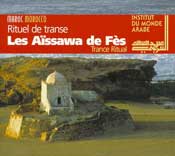Les Aïssawa of Fès
Rituel de Transe
Institut du Monde Arabe
Abdeslam Mouahid El Hadj Abdeslam et al.
La Daqqa, Tambours sacrés de Marrakech
both titles Institut du Monde Arabe (ima.imarabe.org)
 Rituel de Transe is a recording of a concert in Paris from 1994. The ritual music of the Aissawa Sufis tends to be among the most extreme and emotionally intense found in Morocco. The focus is on voice and percussion, usually with the addition of the double-reeded ghaita in a few pieces. The ritual recorded here is in three well-defined parts. After an introductory piece on the ghaita, the first Dhikr begins. This is a highly rhythmic piece with call and response between soloist and choir. The percussion, always present, swells and fades towards the end of each verse. The tempo tends to increase and the rhythm will often shift suddenly to more intense and shorter meters which build to enormous climaxes towards the end of pieces. A complementary pattern usually occurs in the melody, with the pitch gradually getting higher and the phrases shorter and more punctuated. The first part ends in a fury of dense percussion and repeated syllables after 13 minutes.
Rituel de Transe is a recording of a concert in Paris from 1994. The ritual music of the Aissawa Sufis tends to be among the most extreme and emotionally intense found in Morocco. The focus is on voice and percussion, usually with the addition of the double-reeded ghaita in a few pieces. The ritual recorded here is in three well-defined parts. After an introductory piece on the ghaita, the first Dhikr begins. This is a highly rhythmic piece with call and response between soloist and choir. The percussion, always present, swells and fades towards the end of each verse. The tempo tends to increase and the rhythm will often shift suddenly to more intense and shorter meters which build to enormous climaxes towards the end of pieces. A complementary pattern usually occurs in the melody, with the pitch gradually getting higher and the phrases shorter and more punctuated. The first part ends in a fury of dense percussion and repeated syllables after 13 minutes.
The second part is comprised of a single 26-minute suite. Similar in style to the previous two pieces, it alternates call-and-response with swells in the percussion. The piece is interrupted twice by improvised Mawwal. The tension rises and falls with each verse, but still gradually moves upwards. When the level of that tension becomes greatest, it finds release in the big horns which enter. They announce their presence dramatically within four minutes of the end, alternating with the soloist, then together, and with the percussion, eventually overwhelming the soloist. The third part begins with an introductory piece, with the melody played mostly by the piercing ghaitas, preparing the way for the Hadra and the Initiates Dance, the highest point in this ritual. Accompanied by the ghaitas through to the end, the tension is almost unrelieved. One minor complaint with this album is that towards the end of the ritual it gets faded out. This is unfortunate as it was so near the end and inappropriate in music as teologically focused as this.
The second Moroccan release contains a tradition I had not heard before which is unique to an annual festival in Marrakesh. I listened to this CD without reading the liner notes first, which set me up for quite a surprise. From my familiarity with many Moroccan musics, I expected tremendous change in the rhythm, in its dynamics, tempo, and meter. The single, hour-long track started off at a slow tempo accompanied by stately chanting-no surprise there. I expected the piece would gradually speed up and rise in intensity, building up to enormous climaxes and subsiding only to rise again. However, the tempo and rhythmn did not change after 10, 20, 30, 40 minutes. I was growing quite impatient, my expectations completely denied, and I was beginning to think there would never be any change, despite the incredible natural impetus to accelerate in Moroccan rhythm, but close to 10 minutes from the end of the piece, the tempo suddenly became slightly quicker, and after a few minutes the voices suddenly became higher and insistent. From then till the end the tempo became much faster and the texture much denser, shifting to faster metres to reach its apotheosis.
After reading the liner notes, this unusual piece's intent became clear. It becomes an important exercise and lesson in restraint. During the prelude to the Daqqa ceremony, many young men practice the rhythm and drumming techniques to gain admittance to the Daqqa. Those fortunate few participate in the Daqqa which normally lasts for hours. It is very rigidly controlled by older veterans of this ceremony. The slow unchanging part of the Daqqa makes up virtually the entire ceremony. The leader of the Daqqa carefully scrutinizes the young initiates, looking for any sign of impatience or speeding. Upon catching one, the leader throws the initiate's drum to the ground and expels the transgressor. Relief finally comes just before daybreak, when the rhythm is finally let loose. The Daqqa ideally teaches restraint as well as respect for elders. With this knowledge, and the experience of hearing it once, I listen to it without my former expectations and I am able to enjoy its slower pace, though I am ashamed to say I failed my first Daqqa! - David Dalle
Comment on this music or the web site.
Write a Letter to the Editor
